TOP MONTHLY TVNI WEBSITE DOWNLOAD:
The MANUAL ON THE USE AND MANAGEMENT OF VETIVER GRASS (in Spanish) MANUAL SOBRE EL USO Y MANEJO DEL PASTO VETIVER (Chrysopogon zizanioides). This handbook/manual created by Julio Alegre Orihuela Ing. Agrónomo, MS, Ph.D in 2007 has been the top monthly download from the TVNI website since the beginning of 2022 suggesting growing vetiver activity in the Spanish speaking world.
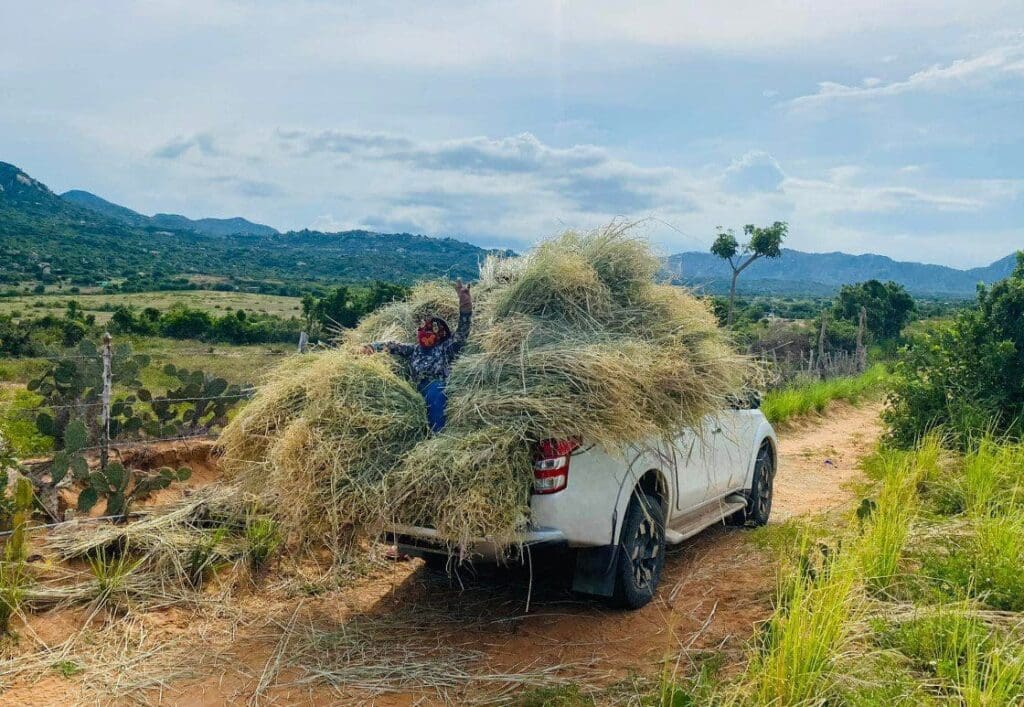
TVNI TECNICAL ADVISORS:
TVNI is aware of some excellent Vetiver System practitioners around the world who have demonstrated prowess in one or more VS applications, and who have shared this knowledge to significantly further the promotion of VS within their own country and to the global Vetiver Community. Some would benefit by having a more formal association with TVNI, especially when working with other organizations. Likewise, TVNI would benefit by being able to call on these practitioners for special assignments and advice. TVNI will offer them TVNI Technical Advisor status allowing them the use of TVNI logo on letter heads, name cards etc. and the option of using a @vetiver.org email account.
The first such Advisor is Ngô Đức Thọ (38) of Vietnam. He is a qualified irrigation and hydroelectricity engineer, a certified organic agriculture consultant, and is completing a Masters degree In Climate Change. He developed and leads the Vietnam Vetiver Farmers Community (6,000 members) including the creation of a market for vetiver seedlings between farmer propagators and those wishing to grow the grass. He advises NGOs in Vietnam to use vetiver in sustainable livelihood projects (Plan International Vietnam, Bread for the World, Nestle Vietnam) in Son La, Lai Chau, Cao Bang, Ha Giang, Quang Tri, Binh Thuan provinces. He advises and encourages many organic agriculture projects businesses and cooperatives to use vetiver grass as a source of mulching biomass, controlling pests, reducing investment costs and adapting to climate change. He has built this vetiver movement through more than 1,500 posts and 10,000 photos of vetiver collected from TVNI, and other sources, including of course Vietnam. Ngô Đức Thọ and is well known as a contributor of substance on our social media platforms. See his recent post about Vietnam farmers and his group His title will be TVNI Farming Advisor.
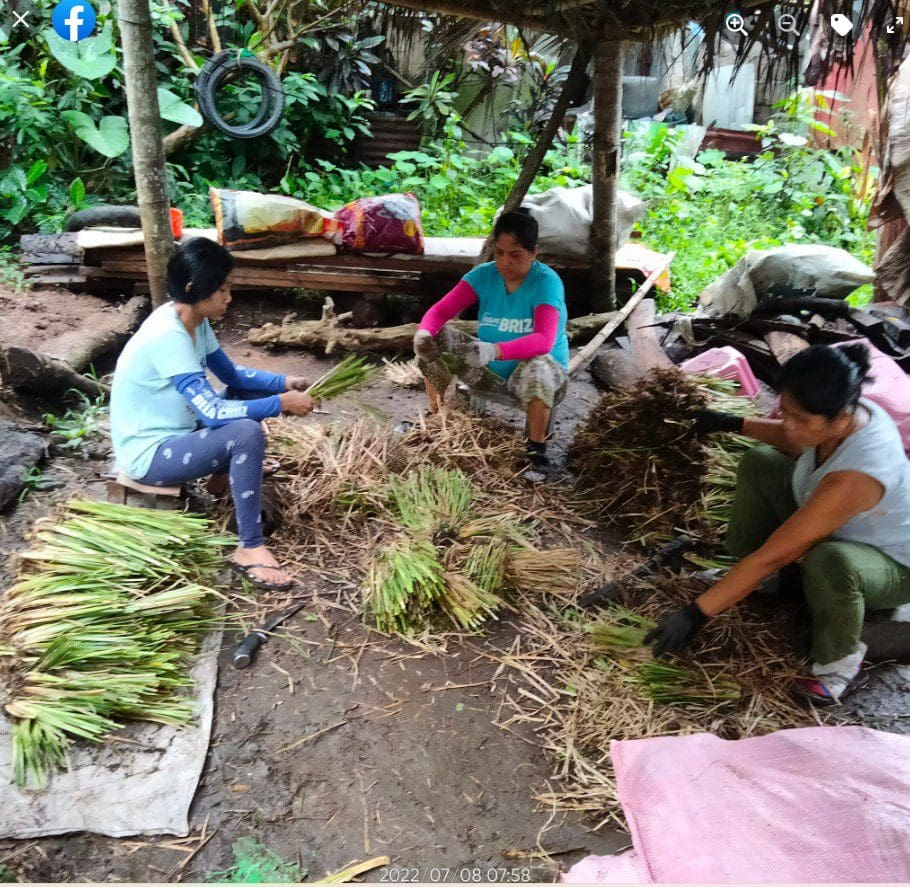
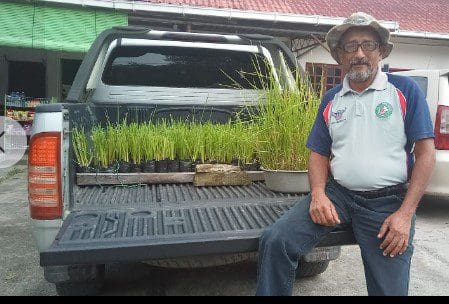
TVNI FACEBOOK ACTIVITY
Has been very active recently and I would draw your attention to some excellent work in the Philippines by Ramil Rosales post (vetiver plant supplier/ application) and Russel Jardiolin a long time “green business” who has been applying vetiver to some large projects for slope stabilization. Ramil started his vetiver business (see video) a few years ago and supplies over 4 million vetiver slips annually to contractors involved with slope stabilization. Apart from his own vetiver nurseries, he subcontracts to small community members to propagate vetiver. His business has expanded into vetiver application at various sites. Mohammad Ariffin Khan from Borneo has been busy improving low-cost propagation techniques including the production of vetiver slips from stem cuttings grown hydroponically in old roof gutters. In this post and others he shows how to make the cuttings.
On the topic of vetiver propagation I want to underscore the importance of developing many reliable vetiver nurseries in communities where Vetiver System is being introduced. These nurseries need not be large, and most should be able to generate some income for the owner (a “green business”). The beauty of vetiver is that it is not going to “go away” if the market demand weakens for a while. ALL the feedback I receive emphasizes the need for significant increases of plant supplies. Note, if you have a nursery please email TVNI with your coordinates and we will be happy to add you to the list of vetiver suppliers on our website
Peter Kingori (Kenya – Trainer of Trainers at Trees for the Future) posted on integrating vetiver with perennial tree crops and embedding vetiver into farm systems. Peter is one of Kenya’s leading farm/agro forestry focused vetiver users, and is a good person to go to for advice.
Himkar Mishra of Samar-Shail Natural Farms, Ramnagar, Purnea India, recently joined our Facebook group. He regularly describes what he is doing on his farm and his extensive food “forests” – vetiver being fundamental to initial establishment. He has just recently posted a video describing how vetiver is critical to the initial development of his food forest, and it is really extraordinary how vetiver enables this very sandy soils to be rehabilitated and flourish.
Combatting climate change …. Autonomous adaption. “A recent study that looked at hundreds of articles and major adaptation support programs and found that individuals and households engaged in smallholder agriculture and/or pastoralism were already taking the lead in seeking and applying solutions. This type of locally-led adaptation – sometimes referred to as autonomous adaptation – accounted for two out of every three concrete actions being taken to adapt to increasingly common, extreme weather events and changing weather patterns”. Read more about this and the role for Vetiver System in Jim Smyle’s recent post.
RECOMMENDED VETIVER FACEBOOK PAGE
— There are many great vetiver sites on various social media pages but this one of Tien Nguyen (Vietnam) drew my attention. Tien Nguyen farms in a dry area of Vietnam and he really is embedding vetiver into his farm. He is also a moderator of the Vietnam Vetiver Farmers group.
VETIVER RESEARCH
— Two research papers caught my eye both of importance for supporting the use of vetiver.
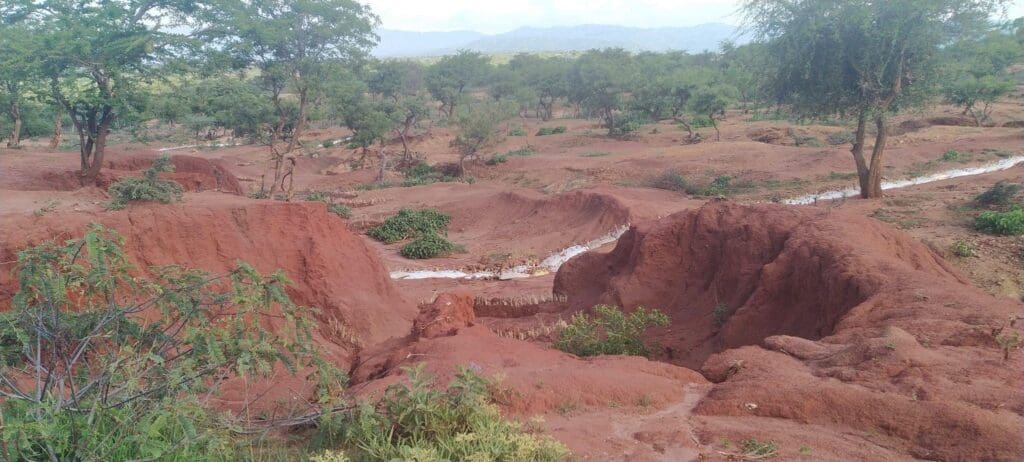
The first from Ethiopia, reports on the impact of vetiver for the control of soil erosion on a small watershed (400ha) located not far from the Jimma Coffee Research Station. The paper “Adoption and Effect of Vetiver Grass on soil Erosion in Somodo Watershed, South-Western Ethiopia” by Gizaw Tesfaye, Yalemtsehay Debebe, and Tesfaye Yakob of the Ethiopian Institute of Agricultural Research at Jimma. The watershed community planted 45 km of vetiver as stand-alone hedgerows and another 95 km on existing soil conservation bunds, protecting about 20% of the watershed.
Some of the key findings of the study are: (a) an average of 36 cm of soil was trapped above the vetiver hedgerows (b) as a result of the trapped soil slopes were reduced by 2.5% (c) these less steep slopes reduced the velocity of runoff, (spreading of water behind the hedgerow … ed), and improving infiltration. Soil moisture content was from 25 – 50% higher than on treated areas, and (d) farmers indicated that soil fertility increased, this was backed up by data showing improved available phosphorous in soil above the hedgerows. There have been a lot of studies on vetiver in Ethiopia, some better than others, but the majority show positive benefits from using vetiver grass hedgerows with recommendations for nation-wide implementation, especially as in this case through community initiative.
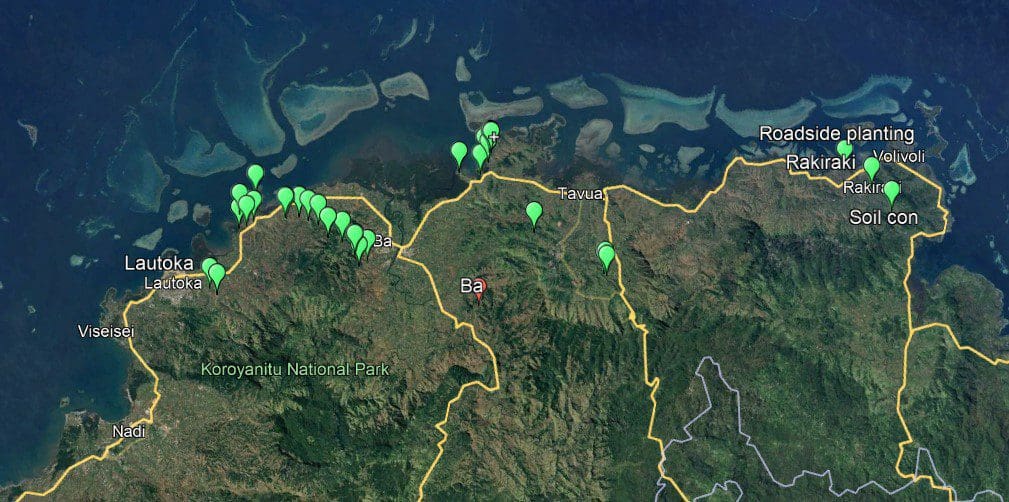
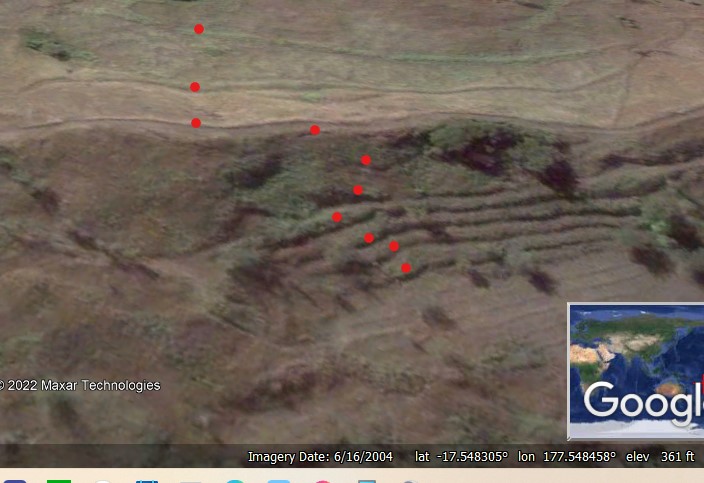
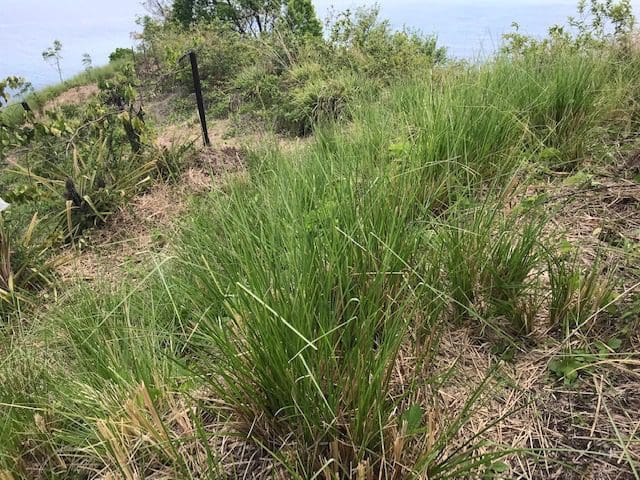
Currently I am reading a book “Shadowing Miss Grimshaw” (a distant cousin who travelled in the South Pacific extensively from 1903- 1935). Her mention of visiting the sugar factory at Ba (Fiji) reminded me that was where John Greenfield worked in the 1950s planting vetiver. So I opened up Google Earth and was able to recognize (thanks to Vonnie Roudette’s ground truthing – ref my June Newsletter) the “signatures” of many, many vetiver hedgerows and/or their remnant terraces. They are literally all over the foothills in the Ba/Lautoka area. You can actually see slope change between some of the hedgerows and some have some pretty high risers (2-3m). These are +/- 70 years old now. It is also interesting to note that there is currently some pretty bad erosion along the northern foothills with sediment seriously effecting adjacent coastal waters. There appears to be much less erosion where vetiver was once planted. We have historical evidence from Fiji and St Vincent of the durability of vetiver (particularly when maintained); research data from Ethiopia and elsewhere that backs up vetiver hedgerows as most effective and the least cost technology for soil erosion control and rainfall conservation, and thousands of farmers who testify to its effectiveness on their farms. …. It’s time for a major upscaling of the technology and one of the best ways of getting it done is, in the absence of government initiatives, to link existing and new green businesses with community based vetiver programs. Critical is the availability of large quantities of vetiver plant material and some practical training of end users.
The second paper (in Spanish): Experimental study of root system of vetiver grass subjected to tensile stress” by Jesús Alberto Torres, Roberto José Torres, Jackeline Coromoto Peña, Ricardo Antonio Picón , Luiggi Méndez, Ruben José Calderas. This paper concludes that the tensile strength of vetiver roots studied has a mean MPa of 118.5. This is significantly higher than the standard of 75 MPa that is generally used. Abstract: An experimental study of the mechanical behavior of the Vetiver grass root system is shown in this paper. Experimental tests of tensile strength (305) were carried out in the primary root system of the Vetiver plant, planted in different soils and different growth states. The methodology starts from the reproduction of the plant and its care in the different types of soil where they were planted. The method proposed by Mickovski and Van Beek was used to prepare experimental tests (1). The results obtained reflect a substantial increase in its tensile strength compared to the strength taken usually for the stabilization designs (75 MPa). The maximum load is increased according to the diameter of the root in a potential relationship, and the traction stress of the Vetiver plant root reaches a mean and moda of 118.5 MPa and 131.71 MPa, respectively.
Another study (in Spanish) reports on a modelling approach taken to try and understand how variable roots sizes, age of plant, and soil textures interact for stabilization. The below graphic from that study, where model was calibrated from 100 lab test readings, reinforces that the average of 75 MPa may be significantly lower than actual.
This research on the strength of vetiver roots reminds me that those of you who have not downloaded Paul Truong’s book “Vetiver Roots – The Hidden Half” might want to do so. It is a most interesting book describing the importance of the plant’s unique root system, along with some excellent photos of vetiver applications globally.
FROM THE NEWSPAPERS
Wastewater pilot project offers promising results – Grass-based system filtering more wastewater than researchers expected (July 11, 2022) – by Dakota Grossman – Maui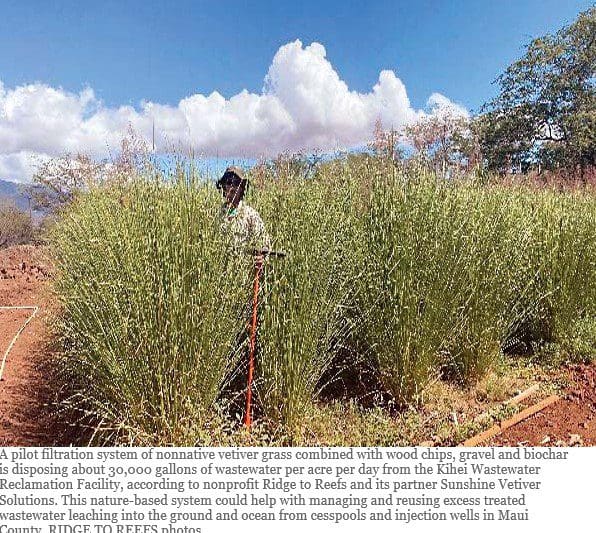 News staff writer – July 11. This is an excellent article about a new pilot project at Kihei Wastewater Reclamation Facility using a vetiver constructed 13,000 sq ft wetland for the treatment of 30,000 gallons/day of R1 wastewater. The pilot, a partnership between the Facility, Ridge to Reefs (R2R), and Sunshine Vetiver Solutions, the latter owned and operated by John Astilla, has been successful.
News staff writer – July 11. This is an excellent article about a new pilot project at Kihei Wastewater Reclamation Facility using a vetiver constructed 13,000 sq ft wetland for the treatment of 30,000 gallons/day of R1 wastewater. The pilot, a partnership between the Facility, Ridge to Reefs (R2R), and Sunshine Vetiver Solutions, the latter owned and operated by John Astilla, has been successful.
“It was pretty amazing,” said John Astilla “We didn’t see any runoff coming from the project site and even walking between the rows, it was saturated but not ponding and it wasn’t mucky.”
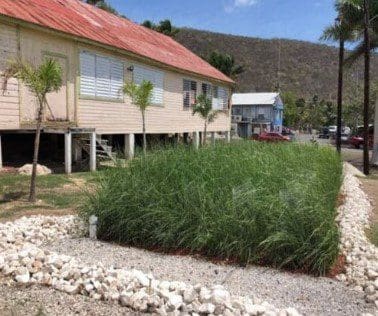
“Growing vetiver grass combined with native plants in rows or in a raised garden bed, which is excavated and filled with recycled wood chips, gravel and biochar, can trap sediment and is efficient at absorbing and removing phosphorus, nitrogen and other nutrients and pollutants that are coming out of Kihei’s wastewater plant before they reach the ocean”. If expanded to 60 acres, all the 2 million gallons from the facility could be treated. Note in Hawaii there are many household septic systems that have by law to be upgraded. At $20,000 per septic system this for many is unaffordable. Vetiver would provide a much more climate friendly, lower cost solution.
Three takeaways from this story: (1) it takes a long time for the adoption of “green solutions”. Paul Truong designed a similar vetiver based system at Boonah, Queensland, Australia in 2011 with 6 acres of vetiver treating 500,000 l/day and has been operating successfully from that time; (2) the concept can be easily applied at small scale for domestic waste water cleanup – an opportunity for small “green businesses”; (3) Vetiver related individuals and organizations should explore the possibility of partnering with Ridge to Reefs programs – R2R is using vetiver on a number of its programs and of course the Vetiver System is a near perfect multi use application that fits well with R2R needs and objectives.
IICA-CBF EbA project provides green business training to improve livelihood opportunities in Dominica and Saint Lucia – Dominica News online – July 11, 2022
“During green business development sit-down sessions, participants learned more about marketing and business establishment through engagement with the team. IAMovement shared the success of the VS and handicraft business in Trinidad and Tobago, along with lessons learnt, and the approach taken for possible replication on the islands, along with other ideas that could be added to their business models for improvement of their programs locally”.
In Dominica, VS training took place with farmers, dwellers and field workers at Petite Soufriere. “The training is aimed at increasing capacity building among participants on the use of nature based and climate smart EbA approaches, VS-VEEP being one such tool for the restoration of marine-coastal ecosystems and upland watersheds, reducing soil erosion and land spillage,” The training concluded with a visit to the community vetiver nursery in San Sauver where participants were exposed to harvesting clumps and preparing vetiver slips.
The IAMovement and its supporting technical partner Vetiver TT is leading the drive in the Caribbean to extend the Vetiver System through communities and their linkages to potential “green businesses”. The core components are: development of vetiver nurseries; the VEEP (Vetiver Education and Empowerment Program) hands on training linked to development of income earning activities such as handicrafts, vetiver plant production and on farm soil improvement (crop increases).
REMINDERS:
Certificates of Technical Excellence. TVNI undertakes the certification of skilled Vetiver System users following a request and submission of evidence by the applicant. Details relating to certification can be found at this link.
Short Video competition:
A reminder that the closing dates for this competition ($8,000 prize money) will be August 31, 2022. If you intend to submit a video please make sure that you meet this deadline. See competition details
TVNI Website registration.
If you want to receive automatic notice of newly published posts or comment on posts, you must be registered. Like most interactive platforms our website gets bombarded by “spam” registrants. Part of the registration process involves setting a new password. The spammers do not generally do this. As of this date those registered users who do NOT set a new password will be deleted from the user list. We apologize in advance if we remove genuine vetiver registrants who have not set their password – you will just have to re-register! – but we have to reduce phony user registrants.
SOME DATA!
June was a busy month and to start this newsletter I thought some TVNI website and Facebook stats for June 2022 might be of interest.
Hello.
The sentence ‘It is also interesting to note that there is currently some pretty bad erosion along the northern foothills with sediment seriously effecting adjacent coastal waters’ currently has advertising for someone’s storefront inserted.
Best Regards
Thanks, how tiresome, have deleted. I wonder how they are able to “hack”
Thank you for the response, Mr Grimshaw. I’ll get someone w/ a Facebook account to check it out for me. Best regards.
I just tested it: https://www.facebook.com/groups/448622132344169/user/100007858474867/ and it worked for me. Try a different browser. I used “Edge”
Hello, the clicking the link to ‘RECOMMENDED VETIVER FACEBOOK PAGE: — There are many great vetiver sites on various social media pages but this one of Tien Nguyen (Vietnam) drew my attention.’ yields the error message ‘This page isn’t available The link you followed may be broken, or the page may have been removed.’
Best Regards